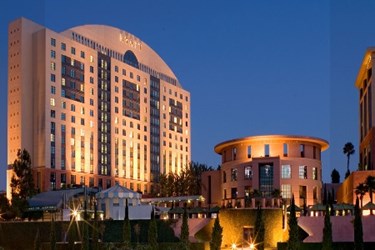IEEE Photonics Conference To Feature Presentations On Quantum-Enabled Lasers, Single-Molecule Nanometric Imaging, High-Q Optical Microcavity Research, And Hybrid Silicon Photonics

The world's foremost photonics scientists, engineers and researchers will gather in San Diego, CA for the IEEE Photonics Conference 2014 (IPC-2014), the photonics industry's premier fall conference. The comprehensive technical program will include presentations that detail the latest breakthroughs in lasers, optoelectronics, optical fiber networks and lightwave technologies by leading researchers from industry, academia and government. Scheduled for 12 - 16 October, 2014 at the Hyatt Regency La Jolla in San Diego, CA, the conference was previously known as the IEEE LEOS Annual Meeting.
The conference is anticipated to include more than 500 technical papers, four invited plenary talks on leading-edge photonics areas, a panel discussion on metamaterials, as well as a series of three Special Symposia designed to explore emerging photonics topics, a short course and several tutorial sessions. There will also be several social events, including an opening reception, a workshop featuring IEEE Photonics Society publication editors and a special reception for Women in Photonics, as well as a manufacturers' exhibition.
"This year's Photonics Conference is once again the IEEE Photonics Society's showcase event for the latest breakthrough developments in photonics technology, their novel applications and future directions," said Dr. Thomas Clark, IPC-2014 Program Chair and supervisor of the Microwave Photonics Section at The Johns Hopkins University Applied Physics Laboratory. "The conference provides a unique combination of industry-leading research, in-depth educational and professional development opportunities, and the chance for attendees to interact with leading photonics professionals from around the world."
Highlights of the 2014 IEEE Photonics Conference include:
- Plenary sessions
- Hybrid Silicon Photonic Integrated Circuits by John Bowers, University of California-Santa Barbara, USA
- Single Molecule Imaging & Nanometry by Toshio Yanagida, Osaka University, Japan
- Exploiting Quantum Coherence For New Technologies (Timing, Navigation & Sensors) by Sir Peter Knight FRS, Imperial College London, UK
- Cold-Mechanics to Stable-Microwaves: The Future of Optical Microcavity Research by Kerry Vahala, California Institute of Technology, USA
Special Symposia
Three special symposia featuring invited speakers supplement the regular conference program:
- Optoelectronic Devices for Solar Energy Harvesting -- includes advances in technological and fundamental aspects of optoelectronic devices for photovoltaics, solar-fuel production, water treatment/desalination and other photocatalytic processes.
- High Power Diode Lasers & Systems -- covers advances along the entire laser technology chain: diode laser sources, beam-combining, optical systems, packaging, reliability, and manufacturing of laser systems for medical, automotive, manufacturing and optical communications applications.
- Optomechanics -- explores developments at the intersection of two previously distinct subjects: Optical (micro-) cavities and micro (nano) mechanical resonators, their related physics and the emergence of opto-mechanical context.
Panel Session on Metamaterials
To update participants on the rapidly-emerging field of photonics metamaterials, a special panel session will be presented to discuss these new materials, devices, applications, as well as their challenges and opportunities. The panel’s organizer is Alexandra Boltasseva, Purdue University, USA, and the panelists are Andrea Alu, University of Texas at Austin, USA; Nader Engheta, University of Pennsylvania, USA; Nanfang Yu, Columbia University, USA; and Zubin Jacob, University of Alberta, Canada.
Tutorial sessions -- These sessions, scheduled throughout the conference, feature invited speakers who provide an overview of various photonics technology areas:
- Optical Nanoantennas by Nader Enghata, University of Pennsylvania, USA
- Plasmonic Nanowire Lasers for Sensors & Integrated Circuits by Volker Sorger, George Washington University, USA
- Quantum Dot & Quantum Well Photonics by Elias Towe, Carnegie Mellon University, USA
- Photonic Advances in Time & Frequency Metrology by Nathan Newbury, National Institute of Standards & Technology (NIST), USA
- Data-Aided Signal Processing for Coherent Optical Receivers by Fabio Pittala, Huawei Technologies, Germany
Short course -- Introduction to Silicon Photonics Device Design & Fabrication (12 October 2014, 12noon - 3:30pm) -- Designed to teach students how to design passive silicon photonic devices using analytic and advanced numerical techniques, the course enables student designs to be fabricated by a state-of-the-art rapid-prototyping 100keV electron-beam lithography facility. All designs will be tested using an automated optical probe station and the data provided to the students for analysis.
"Meet the Editors" Reception & Highlighted Papers Review A new event scheduled for this year's IPC gives participants an opportunity to meet with Carmen Menoni (editor of IEEE Photonics Journal) and Seb Savory (editor of IEEE Photonics Technology Letters) to discuss their respective journals, along with selected "highlight" papers from recent issues of these journals, presented by their authors. The session will be chaired by Martin Dawson, Institute of Physics at the University of Strathclyde, Scotland.
For more information, visit http://www.ipc-ieee.org/.
About The IEEE Photonics Society
The IEEE Photonics Society is one of the world's leading technical communities in the field of optoelectronics and photonic materials, devices, and systems, with members and activities engaged in research, development, design, manufacture, and applications, as well as with the various other activities necessary for the useful expansion of the field. As part of this dynamic worldwide community, more than 100,000 photonics professionals actively organize, contribute to, and participate in Society technical conferences, journals and other activities covering all aspects of the field. The IEEE Photonics Society has 75+ worldwide chapters and is part of IEEE, the world’s largest technical professional association. The IEEE Photonics Society (IPS) is the new name for the former IEEE Lasers and Electro-Optics Society (LEOS). For more information, visit http://www.photonicssociety.org.
About IEEE
IEEE, the world's largest technical professional association, is dedicated to advancing technology for the benefit of humanity. Through its highly cited publications, conferences, technology standards, and professional and educational activities, IEEE is the trusted voice on a wide variety of areas ranging from aerospace systems, computers and telecommunications to biomedical engineering, electric power and consumer electronics. For more information, visit http://www.ieee.org.
Source: IEEE Photonics
